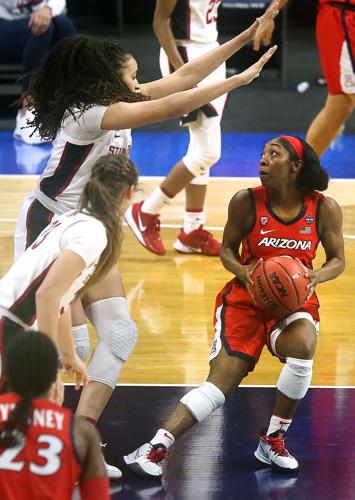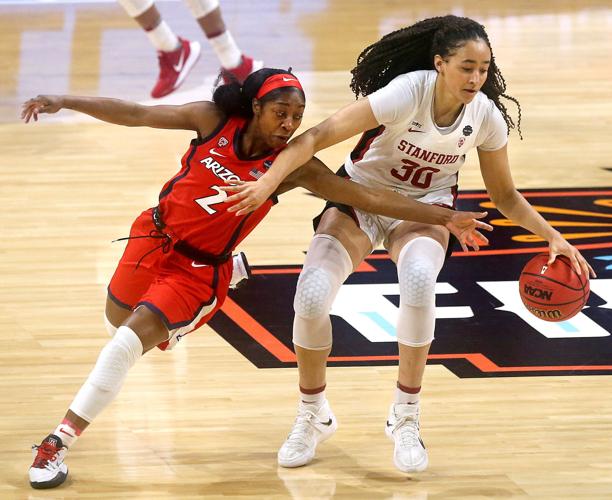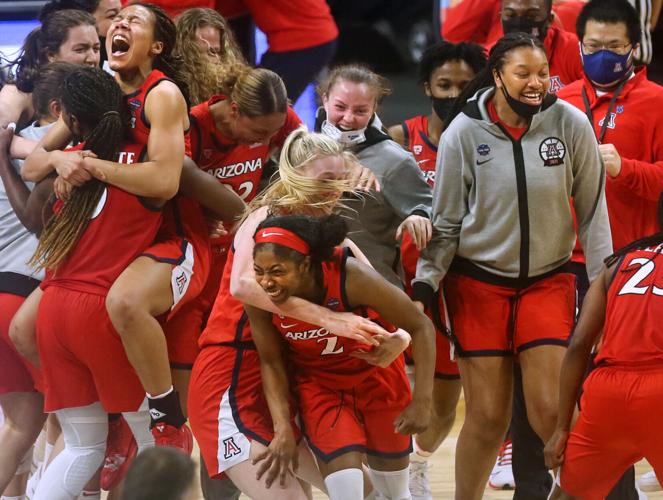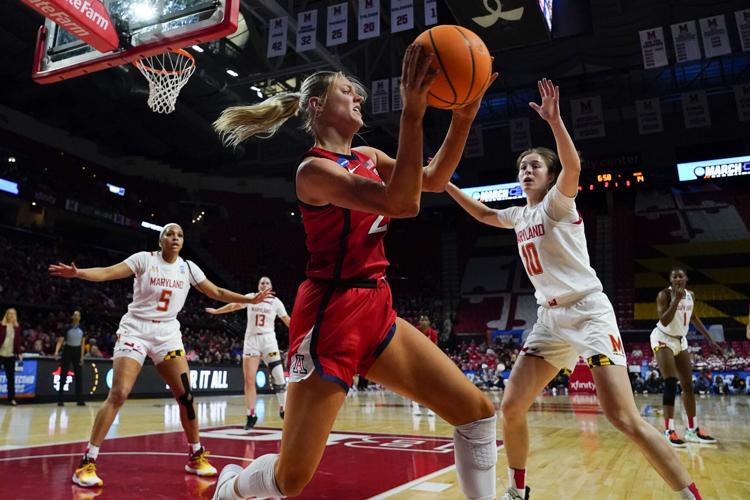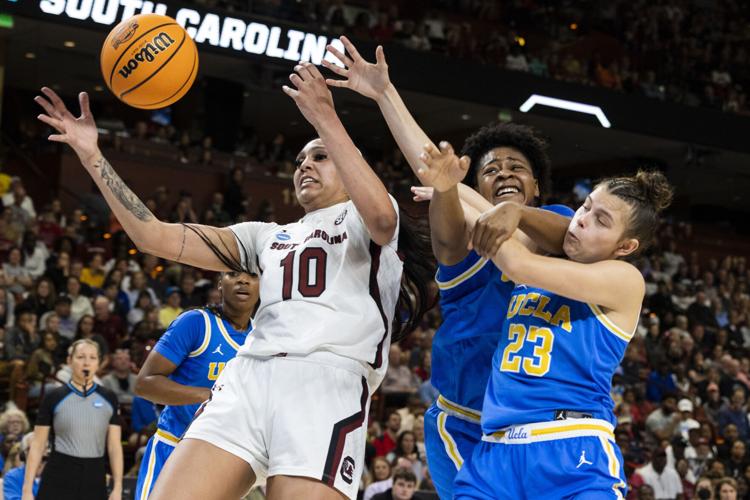It’s been two years since, arguably, the greatest March Madness in Pac-12 history.
On the men’s side, all five schools (Colorado, Oregon, Oregon State, UCLA and USC) that made the Big Dance in the Indianapolis bubble won at least one game. The conference had four schools in the Sweet 16, three in the Elite Eight and one, UCLA, in the Final Four.
Down in San Antonio for the women’s tournament, things were even better. Six schools (Arizona, Oregon, Oregon State, Stanford, UCLA and Washington State) went dancing, with five winning a game, three making the Sweet 16 and two, Stanford and Arizona, going all the way to an all-Pac-12 national championship game.
Between the two tournaments, Pac-12 schools picked up 28 wins in 2021.
But the financial impact of those wins on the conference, in a financial sense, couldn’t be any different.
On the men’s side, the Pac-12 brought home nearly $40 million from the 2021 tournament.
On the women’s side? $0.

Arizona Wildcats forward Cate Reese (25) and Arizona Wildcats guard Aari McDonald (2) celebrate with their teammates after defeating UConn in the semifinals of the 2011 women's NCAA Tournament at the Alamodome in San Antonio, Texas on April 2, 2021. That 2021 tournament is arguably the most successful run for the Pac-12's women's programs ever, capping with Arizona and Stanford squaring off for the national title.
The reason is the unit system, which sends about 19.5% of the $867.5 million received for the TV rights to the men’s tournament — or $168.8 million — into what’s called the Basketball Performance Fund (BPF).
The BPF awards one unit to a conference for each game played by its teams (except for the national championship). Those units are pooled and carried forward for six years. Each unit has a dollar value that increases by about three percent each year of the payout cycle.
For the men’s side, the Pac-12 received 19 units in 2021, and using figures provided to the Hotline by the NCAA, each unit was worth $2,034,061 over the six years.
Take that amount, multiply it by 19 units and you get $38,647,159 for the conference just from the 2021 men’s tournament performance. Split that up by the 12 schools and it’s a $3.22 million influx of cash per campus.
That’s a pretty good payout. A system like that has never been implemented on the women’s side.
But after the many issues surrounding the 2021 women’s tournament — which were brought to light by Pac-12 people, like Oregon basketball player Sedona Prince and Stanford athletic trainer Ali Kershner — the NCAA hired a law firm to review gender equity issues.
The report found that the current NCAA television deal, which packages the women’s tournament with 28 other NCAA championships for an average amount of $34 million, significantly undersells the value of the women’s basketball rights.
In fact, estimates show that the women’s tournament on its own could be worth “between $81 and $112 million annually beginning in 2025.”
That estimate seems to support the idea that women’s basketball could be considered a self-sufficient sport by the NCAA. And, if the money’s there, several prominent coaches would support a unit system on the women’s side, like the men’s.
“I think it’s a good idea to do,” said Tara VanDerveer, head coach at Stanford and 2021 national champion.
You can also count South Carolina coach Dawn Staley and UCLA coach Cori Close as coaches in favor of the unit system. They see it as a way for women’s basketball programs to help other athletic programs, too.
“We’re at that place where we’re in high demand,” Staley said. “I do believe that women’s basketball can stand on its own and be a huge revenue-producing sport that can do, to a certain extent, what men’s basketball has done for all those other Olympic sports.”
Close, who is also the president of the Women’s Basketball Coaches Association, added:
“I don’t think any of us are asking to be just like the men, obviously they’re ahead of us in that deal … We want to grow the pie. I think it’s more of an opportunity. It’s an opportunity to be a valuable resource on our campuses.”
Staley and VanDerveer both made note of the increased attention towards the women’s game, both with crowds — the first weekend set an NCAA attendance record — and on television, with ESPN reporting viewership was up 28% from last year for first and second round games.
It’s why all signs point to a separate media deal for the women’s tournament and, potentially, a unit system that VanDerveer would support.
“When you attach money to something, it attaches importance to it. And so if there are units, then that’s saying it’s important. And I think that is important,” VanDerveer said. “But, when we keep doing the things that we’re doing, we’re not really putting our money where our mouth is.”
Stanford has been the standard bearer for the Pac-12 on the women’s side, with its 100th NCAA Tournament victory coming in this year’s first round.
When asked about the benefits of bringing the unit system to the women’s side of basketball, VanDerveer quipped, “Do some math and figure out how much we would have made.”
Pac-12 Hotline: Three members of the Pac-12 advanced to the Sweet 16 in the NCAA Women's Tournament, but it's hard to get past the disappointment of No. 1 seed Stanford not being one of them.
While it would be difficult to do the math for all 100 wins, we can spotlight 2021 as a specific example. It isn’t totally clear what the exact unit system would be, but for the sake of an estimate, let’s mirror the men’s structure.
Using the high end of the gender equity review’s estimate of $112 million and the same unit setup as the men (with the BPF just under 19.5% of the television revenue), a women’s BPF would be worth $21,793,199.
A men’s unit in 2022 was $338,211 — around 0.2% of the BPF.
If we use the same scale, a women’s basketball unit for 2022 would be worth $43,655.
For the sake of simplicity, we will not add the 3 percent increase to each season. But even taking that one unit and multiplying it by six seasons, a unit’s full worth is $261,930.
Remember the numbers up top, about how well the Pac-12 did in the 2021 women’s tournament? That performance would have been good for 18 units.
So the hypothetical total for the Pac-12 in 2021 would be $4,714,740.
Divide that up among the schools evenly and each athletic department would get $392,895.
It’s not in the millions. But it’s a whole lot more than zero.
I called VanDerveer with the math this week after Stanford’s stunning upset loss to Ole Miss. The coach still insisted I try to go all the way back to when the unit system began and map out how much money the Stanford women could have made for the Pac-12 if the unit system always mirrored the men.
But when told the number from the hypothetical 2021 year, her reaction was simple.
“That’s significant,” VanDerveer said. “That’s significant, don’t you think?”
VanDerveer has been a vocal supporter of the conference for a long time now. She even has her own program following that mindset, with Stanford players cheering on every Pac-12 school named during the selection show and players like Haley Jones closely following other Pac-12 games on their off days.
Even though Stanford surprisingly missed out on the Sweet 16 for the first time since 2007, three Pac-12 schools did get that far: Colorado, UCLA and Utah.

South Carolina's Kamilla Cardoso, left, fights for a rebound with UCLA's Gabriela Jaquez, right, and Christeen Iwuala in the first half of Saturday's Sweet 16 game in Greenville, S.C.
All three ended up falling short of advancing past the Sweet 16;UCLA fell to top-ranked South Carolina, Utah lost to LSU and Colorado was knocked out by Iowa.
But VanDerveer was fully rooting for all three, even sending texts to the three head coaches there; all three did end up falling in the Sweet 16 (
“Just wishing them good luck and to represent,” she said. “We want them to do well.”
Perhaps as soon as two years from now, the conference’s schools can benefit from that success financially, too.
<&rule>
<&rule>
Number one Indiana Hoosiers lost to number eight Miami Hurricanes 70-68 in round two of the women's NCAA tournament.
The UA women's basketball team runs drills at Xfinity Center Thursday, the day before the No. 7-seed Wildcats defeated No. 10-seed West Virginia, 75-62 in the first round of the 2023 NCAA Tournament. Video by PJ Brown/Arizona Daily Star
The UA women's basketball team runs defensive drills at Xfinity Center Thursday, the day before the No. 7-seed Wildcats defeated No. 10-seed West Virginia, 75-62 in the first round of the 2023 NCAA Tournament. Video by PJ Brown/Arizona Daily Star
Photos: Arizona vs. Stanford, NCAA Women's Basketball National Championship game
Arizona, Stanford, 2021 NCAA Women's Basketball National Championship
Updated
From left to right Arizona Wildcats guard Aari McDonald (2), Stanford Cardinal guard Lexie Hull (12), Arizona Wildcats forward Trinity Baptiste (0), Stanford Cardinal forward Cameron Brink (22) and Arizona Wildcats forward Sam Thomas (14) make a move towards the ball in the second half during the NCAA Tournament National Championship game at the Alamodome in San Antonio, Texas on April 4, 2021. Stanford won 54-53.
Arizona, Stanford
Updated
Arizona Wildcats forward Lauren Ware (32) tries to grab the loose ball as Stanford Cardinal forward Cameron Brink (22) gets up and Arizona Wildcats guard Helena Pueyo (13) chses it in the second half during the NCAA Tournament National Championship game at the Alamodome in San Antonio, Texas on April 4, 2021. Stanford won 54-53.
Arizona, Stanford, 2021 NCAA Women's Basketball National Championship
Updated
The Arizona bench comes together to watch the seconds of the game against Stanford in the second half during the NCAA Tournament National Championship game at the Alamodome in San Antonio, Texas on April 4, 2021. Stanford won 54-53.
Arizona, Stanford
Updated
Arizona Wildcats guard Bendu Yeaney (23) and Arizona Wildcats guard Shaina Pellington (1) walk away from the huddle after Stanford wins the NCAA Tournament National Championship game at the Alamodome in San Antonio, Texas on April 4, 2021. Stanford won 54-53.
Arizona, Stanford, 2021 NCAA Women's Basketball National Chamionship
Updated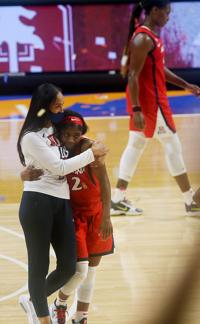
Arizona Wildcats guard Aari McDonald (2) is comforted as the Wildcats leave the floor after losing to Stanford in NCAA Tournament National Championship game at the Alamodome in San Antonio, Texas on April 4, 2021. Stanford won 54-53.
Arizona, Stanford, 2021 NCAA Women's Basketball National Chamionship
Updated
As the confetti falls Arizona forward Sam Thomas (14) and her teammates wave to fans after losing to Stanford in the NCAA Tournament championship game at the Alamodome in San Antonio on April 4, 2021. Stanford won 54-53.
Arizona, Stanford, 2021 NCAA Women's Basketball National Championship
Updated
Arizona Wildcats forward Trinity Baptiste (0) passes the ball around the leg o fStanford Cardinal forward Cameron Brink (22) in the second half during the NCAA Tournament National Championship game at the Alamodome in San Antonio, Texas on April 4, 2021. Stanford won 54-53.
Arizona, Stanford, 2021 NCAA Women's Basketball National Chamionship
Updated
Stanford Cardinal forward Cameron Brink (22) gets her hands on the ball as Arizona Wildcats forward Cate Reese (25) tries to shoot in the second half during the NCAA Tournament National Championship game at the Alamodome in San Antonio, Texas on April 4, 2021. Stanford won 54-53.
Arizona, Stanford, 2021 NCAA Women's Basketball National Chamionship
Updated
in the first half during the NCAA Tournament National Championship game at the Alamodome in San Antonio, Texas on April 4, 2021.
Arizona, Stanford, 2021 NCAA Women's Basketball National Chamionship
Updated
Arizona Wildcats head coach Adia Barnes talks with Arizona Wildcats forward Trinity Baptiste (0) in the first half during the NCAA Tournament National Championship game at the Alamodome in San Antonio, Texas on April 4, 2021.
Arizona, Stanford, 2021 NCAA Women's Basketball National Chamionship
Updated
Arizona Wildcats guard Aari McDonald (2) eyes the basket as Stanford defenders watch in the first half during the NCAA Tournament National Championship game at the Alamodome in San Antonio, Texas on April 4, 2021.
Arizona, Stanford, 2021 NCAA Women's Basketball National Chamionship
Updated
Arizona Wildcats forward Cate Reese (25) tries to grab the ball from Stanford Cardinal forward Ashten Prechtel (11) in the first half during the NCAA Tournament National Championship game at the Alamodome in San Antonio, Texas on April 4, 2021.
NCAA Tournament National Championship: No. 3 Arizona vs. No. 1 Stanford
Updated
Arizona guard Aari McDonald, right, is met by Stanford defenders, including guard Haley Jones (30), in the second half of the NCAA Tournament championship game at the Alamodome in San Antonio on April 4, 2021. Stanford won 54-53.
NCAA Tournament National Championship: No. 3 Arizona vs. No. 1 Stanford

Arizona Wildcats guard Aari McDonald (2) lays on the ground as Stanford Cardinal guard Lexie Hull (12) walks away in the second half during the NCAA Tournament National Championship game at the Alamodome in San Antonio, Texas on April 4, 2021. Stanford won 54-53.
Arizona, Stanford, 2021 NCAA Women's Basketball National Chamionship
Updated
Arizona and Stanford players each reach for the rebound in the first half during the NCAA Tournament National Championship game at the Alamodome in San Antonio, Texas on April 4, 2021.
Arizona, Stanford, 2021 NCAA Women's Basketball National Chamionship
Updated
Arizona guard Aari McDonald (2) passes between Stanford guard Anna Wilson (3) and forward Cameron Brink, right, during the second half of the championship game in the women's Final Four NCAA college basketball tournament, Sunday, April 4, 2021, at the Alamodome in San Antonio. (AP Photo/Eric Gay)
Arizona, Stanford, 2021 NCAA Women's Basketball National Chamionship
Updated
Arizona forward Cate Reese (25) fights for possession of the ball with Stanford guard Haley Jones, right, during the first half of the championship game in the women's Final Four NCAA college basketball tournament, Sunday, April 4, 2021, at the Alamodome in San Antonio. (AP Photo/Eric Gay)
Arizona, Stanford, 2021 NCAA Women's Basketball National Chamionship
Updated
Players get set for the opening tipoff of the championship game between Stanford and Arizona in the women's Final Four NCAA college basketball tournament, Sunday, April 4, 2021, at the Alamodome in San Antonio. (AP Photo/Morry Gash)
Arizona, Stanford, 2021 NCAA Women's Basketball National Chamionship
Updated
Fans watch from the stands during the first half of the championship game between Stanford and Arizona in the women's Final Four NCAA college basketball tournament, Sunday, April 4, 2021, at the Alamodome in San Antonio. (AP Photo/Eric Gay)
Arizona, Stanford, 2021 NCAA Women's Basketball National Chamionship
Updated
Stanford guard Haley Jones (30) drives up court ahead of Arizona guard Aari McDonald, left, during the first half of the championship game in the women's Final Four NCAA college basketball tournament, Sunday, April 4, 2021, at the Alamodome in San Antonio. (AP Photo/Eric Gay)
Arizona, Stanford, 2021 NCAA Women's Basketball National Chamionship
Updated
Stanford guard Haley Jones (30) drives to the basket over Arizona forward Cate Reese (25) during the first half of the championship game in the women's Final Four NCAA college basketball tournament, Sunday, April 4, 2021, at the Alamodome in San Antonio. (AP Photo/Eric Gay)
Arizona, Stanford, 2021 NCAA Women's Basketball National Chamionship
Updated
Stanford guard Lexie Hull (12) drives past Arizona forward Trinity Baptiste (0) during the first half of the championship game in the women's Final Four NCAA college basketball tournament, Sunday, April 4, 2021, at the Alamodome in San Antonio. (AP Photo/Morry Gash)
Arizona, Stanford, 2021 NCAA Women's Basketball National Chamionship
Updated
Arizona forward Cate Reese, center, shoots over Stanford guard Haley Jones, left, and forward Cameron Brink, right, during the first half of the championship game in the women's Final Four NCAA college basketball tournament, Sunday, April 4, 2021, at the Alamodome in San Antonio. (AP Photo/Eric Gay)
Arizona, Stanford, 2021 NCAA Women's Basketball National Chamionship
Updated
Arizona forward Sam Thomas, left, fights for a loose ball with Stanford forward Ashten Prechtel, right, during the first half of the championship game in the women's Final Four NCAA college basketball tournament, Sunday, April 4, 2021, at the Alamodome in San Antonio. (AP Photo/Eric Gay)
Arizona, Stanford, 2021 NCAA Women's Basketball National Chamionship
Updated
Arizona forward Sam Thomas, left, fights for possession of the ball with Stanford forward Ashten Prechtel, right, during the first half of the championship game in the women's Final Four NCAA college basketball tournament, Sunday, April 4, 2021, at the Alamodome in San Antonio. (AP Photo/Eric Gay)
Arizona, Stanford, 2021 NCAA Women's Basketball National Chamionship
Updated
Arizona forward Sam Thomas (14) fights for a loose ball with Stanford forward Ashten Prechtel, right, during the first half of the championship game in the women's Final Four NCAA college basketball tournament, Sunday, April 4, 2021, at the Alamodome in San Antonio. (AP Photo/Morry Gash)
Arizona, Stanford, 2021 NCAA Women's Basketball National Chamionship
Updated
Arizona guard Shaina Pellington (1) drives to the basket ahead of Stanford guard Lexie Hull (12) during the first half of the championship game in the women's Final Four NCAA college basketball tournament, Sunday, April 4, 2021, at the Alamodome in San Antonio. (AP Photo/Eric Gay)
Arizona, Stanford, 2021 NCAA Women's Basketball National Chamionship
Updated
Arizona guard Aari McDonald (2) looks to grab a loose ball between Stanford guard Anna Wilson (3) and forward Alyssa Jerome (10) during the first half of the championship game in the women's Final Four NCAA college basketball tournament, Sunday, April 4, 2021, at the Alamodome in San Antonio. (AP Photo/Morry Gash)
Arizona, Stanford, 2021 NCAA Women's Basketball National Chamionship
Updated
Stanford guard Kiana Williams (23) loses control of the ball in front of Arizona guard Aari McDonald (2) during the first half of the championship game in the women's Final Four NCAA college basketball tournament, Sunday, April 4, 2021, at the Alamodome in San Antonio. (AP Photo/Morry Gash)
Arizona, Stanford, 2021 NCAA Women's Basketball National Chamionship
Updated
Arizona head coach Adia Barnes directs her team during the first half of the championship game against Stanford in the women's Final Four NCAA college basketball tournament, Sunday, April 4, 2021, at the Alamodome in San Antonio. (AP Photo/Morry Gash)
Arizona, Stanford, 2021 NCAA Women's Basketball National Chamionship
Updated
Stanford head coach Tara VanDerveer directs her team during the first half of the championship game against Arizona in the women's Final Four NCAA college basketball tournament, Sunday, April 4, 2021, at the Alamodome in San Antonio. (AP Photo/Morry Gash)
Arizona, Stanford, 2021 NCAA Women's Basketball National Chamionship
Updated
Fans sit among cardboard cutouts in the stands before the championship game between Stanford and Arizona in the women's Final Four NCAA college basketball tournament, Sunday, April 4, 2021, at the Alamodome in San Antonio. (AP Photo/Morry Gash)
Arizona, Stanford, 2021 NCAA Women's Basketball National Chamionship
Updated
Stanford guard Anna Wilson shoots over Arizona forward Sam Thomas (14) during the second half of the championship game in the women's Final Four NCAA college basketball tournament, Sunday, April 4, 2021, at the Alamodome in San Antonio. (AP Photo/Morry Gash)
NCAA Tournament National Championship: No. 3 Arizona vs. No. 1 Stanford

An Arizona fan stands for the National Anthem before the start of the NCAA Tournament National Championship game against Stanford at the Alamodome in San Antonio, Texas on April 4, 2021. Stanford won 54-53.
Photos: No. 3 Arizona Wildcats beat No. 1 UConn Huskies in NCAA Tournament Final Four
NCAA Tournament Final Four: No. 3 seed Arizona vs. No. 1 seed UConn
Updated
Cate Reese and Aari McDonald celebrate as the Arizona Wildcats defeated UConn to advance to the NCAA Women's National Championship game.
NCAA Tournament Final Four: No. 3 seed Arizona vs. No. 1 seed UConn
Updated
Aari McDonald, left, hugs another teammate as the Arizona Wildcats defeated UConn to advance to the NCAA Women's National Championship game.
NCAA Tournament Final Four: No. 3 seed Arizona vs. No. 1 seed UConn
Updated
Cydney Walters, center, leaps out of her seat as she and Ariel Shirley, left,, and Lauryn Thomas celebrate the final whistle of the Wildcat's over UConn in the Final Four at Union Public House at St. Philip's Plaza, Tucson, Ariz., April 2, 2021.
NCAA Tournament Final Four: No. 3 seed Arizona vs. No. 1 seed UConn
Updated
Arizona Wildcats guard Helena Pueyo (13) grabs the rebound over UConn Huskies forward Aaliyah Edwards (3) in the second half during the NCAA Tournament Final Four game at the Alamodome in San Antonio, Texas on April 2, 2021. Arizona won 69-59 and is headed to the National Championship.
NCAA Tournament Final Four: No. 3 seed Arizona vs. No. 1 seed UConn
Updated
UConn Huskies guard Christyn Williams (13) has some words with a referee as her teammate UConn Huskies guard Paige Bueckers (5) lays on the ground in the second half during the NCAA Tournament Final Four game at the Alamodome in San Antonio, Texas on April 2, 2021. Arizona won 69-59.
NCAA Tournament Final Four: No. 3 seed Arizona vs. No. 1 seed UConn
Updated
Arizona Wildcats forward Trinity Baptiste (0) and Arizona Wildcats guard Bendu Yeaney (23) guard UConn Huskies guard Paige Bueckers (5) in the second half during the NCAA Tournament Final Four game at the Alamodome in San Antonio, Texas on April 2, 2021. Arizona won 69-59.
Arizona vs UConn, NCAA Tournament
Updated
UConn Huskies guard Paige Bueckers (5) is shut down by Arizona defenders Cate Reese and Aari McDonald in the first half during the NCAA Tournament Final Four game at the Alamodome in San Antonio, Texas on April 2, 2021.
Arizona vs UConn, NCAA Tournament
Updated
Arizona Wildcats guard Helena Pueyo (13) tries to block the shot of UConn Huskies guard Paige Bueckers (5) in the first half during the NCAA Tournament Final Four game at the Alamodome in San Antonio, Texas on April 2, 2021.
Arizona vs UConn, NCAA Tournament
Updated
Arizona Wildcats forward Cate Reese (25) is defended by UConn Huskies forward Aaliyah Edwards (3) in the first half during the NCAA Tournament Final Four game at the Alamodome in San Antonio, Texas on April 2, 2021.
Arizona vs UConn, NCAA Tournament
Updated
Arizona Wildcats guard Aari McDonald (2) makes a drive as UConn Huskies guard Christyn Williams (13) tries to defend in the first half during the NCAA Tournament Final Four game at the Alamodome in San Antonio, Texas on April 2, 2021.
NCAA Tournament Final Four: No. 3 seed Arizona vs. No. 1 seed UConn
Updated
Arizona Wildcats forward Cate Reese (25) eyes the basket over UConn Huskies guard Nika Muhl (10) and UConn Huskies guard Christyn Williams (13) in the second half during the NCAA Tournament Final Four game at the Alamodome in San Antonio, Texas on April 2, 2021. Arizona won 69-59 and is headed to the National Championship game.
Arizona vs UConn, NCAA Tournament
Updated
Arizona Wildcats forward Cate Reese (25) embraces Arizona Wildcats guard Aari McDonald (2) after she hit a three-pointer in the first half during the NCAA Tournament Final Four game at the Alamodome in San Antonio, Texas on April 2, 2021.
Arizona vs UConn, NCAA Tournament
Updated
Arizona Wildcats guard Bendu Yeaney (23) looks to mak ethe pass to Arizona Wildcats forward Sam Thomas (14) in the first half during the NCAA Tournament Final Four game at the Alamodome in San Antonio, Texas on April 2, 2021.
NCAA Tournament Final Four: No. 3 seed Arizona vs. No. 1 seed UConn
Updated
An Arizona fan dances to music in the arena during a timeout in the second half during the NCAA Tournament Final Four game at the Alamodome in San Antonio, Texas on April 2, 2021. Arizona beat UConn 69-59.
Arizona vs. UConn, NCAA Tournament
Updated
After grabbing the rebound, Arizona Wildcats forward Sam Thomas (14) looks to make a basket as she's surrounded by UConn defenders in the first half during the NCAA Tournament Final Four game at the Alamodome in San Antonio, Texas on April 2, 2021.
NCAA Tournament Final Four: No. 3 seed Arizona vs. No. 1 seed UConn
Updated
Arizona fans sit amongst the cardboard cutouts as they cheer on the Wildcats against the UConn Huskies in the first half during the NCAA Tournament Final Four game at the Alamodome in San Antonio, Texas on April 2, 2021. Arizona won 69-59 and is headed to the National Championship.
Arizona vs UConn, NCAA Tournament
Updated
Arizona guard Aari McDonald (2) saves the ball from going out of bounds during the second half of a women's Final Four NCAA college basketball tournament semifinal game against Connecticut Friday, April 2, 2021, at the Alamodome in San Antonio. (AP Photo/Morry Gash)
Arizona vs UConn, NCAA Tournament
Updated
Connecticut guard Paige Bueckers (5) passes over Arizona guard Aari McDonald (2) during the first half of a women's Final Four NCAA college basketball tournament semifinal game Friday, April 2, 2021, at the Alamodome in San Antonio. (AP Photo/Eric Gay)
Arizona vs UConn, NCAA Tournament
Updated
Arizona guard Aari McDonald (2) drives around Connecticut guard Evina Westbrook (22) during the first half of a women's Final Four NCAA college basketball tournament semifinal game Friday, April 2, 2021, at the Alamodome in San Antonio. (AP Photo/Eric Gay)
Arizona vs UConn, NCAA Tournament
Updated
Connecticut forward Olivia Nelson-Ododa, rear, blocks a shot by Arizona forward Cate Reese during the first half of a women's Final Four NCAA college basketball tournament semifinal game Friday, April 2, 2021, at the Alamodome in San Antonio. (AP Photo/Eric Gay)
052121-tuc-spt-uawomenshoops-p1
Updated
Adia Barnes coached against Geno Auriemma and Tara VanDerveer in the Final Four, and will line up against Hall of Famer C. Vivian Stringer in this year’s Paradise Jam.
Arizona vs UConn, NCAA Tournament
Updated
Arizona guard Shaina Pellington (1) drives up court ahead of Connecticut guard Evina Westbrook (22) and guard Paige Bueckers (5) during the first half of a women's Final Four NCAA college basketball tournament semifinal game Friday, April 2, 2021, at the Alamodome in San Antonio. (AP Photo/Eric Gay)
Arizona vs UConn, NCAA Tournament
Updated
Arizona guard Shaina Pellington (1) celebrates after getting fouled by Connecticut guard Christyn Williams, left, during the first half of a women's Final Four NCAA college basketball tournament semifinal game Friday, April 2, 2021, at the Alamodome in San Antonio. (AP Photo/Eric Gay)
Arizona vs UConn, NCAA Tournament
Updated
Arizona guard Helena Pueyo (13) grabs a rebound over Connecticut forward Aubrey Griffin (44) during the first half of a women's Final Four NCAA college basketball tournament semifinal game Friday, April 2, 2021, at the Alamodome in San Antonio. (AP Photo/Eric Gay)
Arizona vs UConn, NCAA Tournament
Updated
Connecticut forward Olivia Nelson-Ododa (20) is fouled by Arizona forward Lauren Ware, rear, during the second half of a women's Final Four NCAA college basketball tournament semifinal game Friday, April 2, 2021, at the Alamodome in San Antonio. (AP Photo/Eric Gay)
Arizona vs UConn, NCAA Tournament
Updated
Arizona guard Helena Pueyo (13) shoots over Connecticut guard Paige Bueckers (5) during the second half of a women's Final Four NCAA college basketball tournament semifinal game Friday, April 2, 2021, at the Alamodome in San Antonio. (AP Photo/Eric Gay)
Arizona vs UConn, NCAA Tournament
Updated
Arizona forward Trinity Baptiste (0) grabs a rebound between Connecticut guard Christyn Williams (13) and forward Aaliyah Edwards, right, during the second half of a women's Final Four NCAA college basketball tournament semifinal game Friday, April 2, 2021, at the Alamodome in San Antonio. (AP Photo/Morry Gash)


